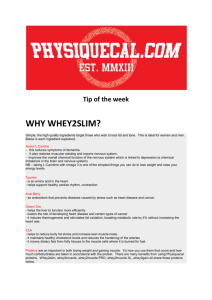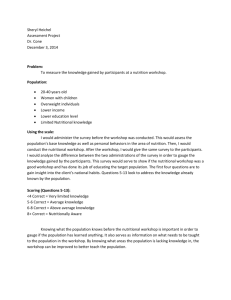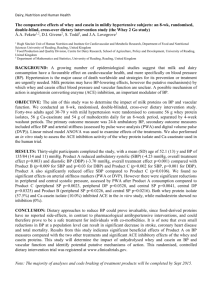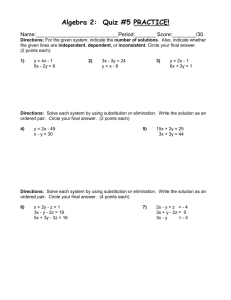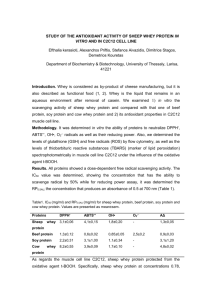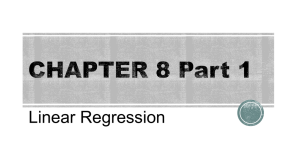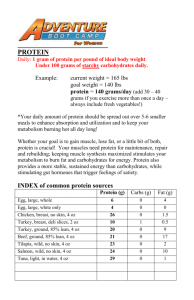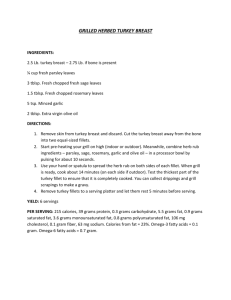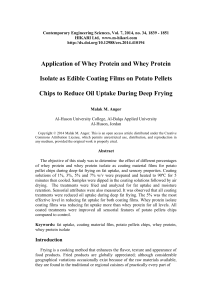Basic Diet Advice - AlaskaFit Productions
advertisement
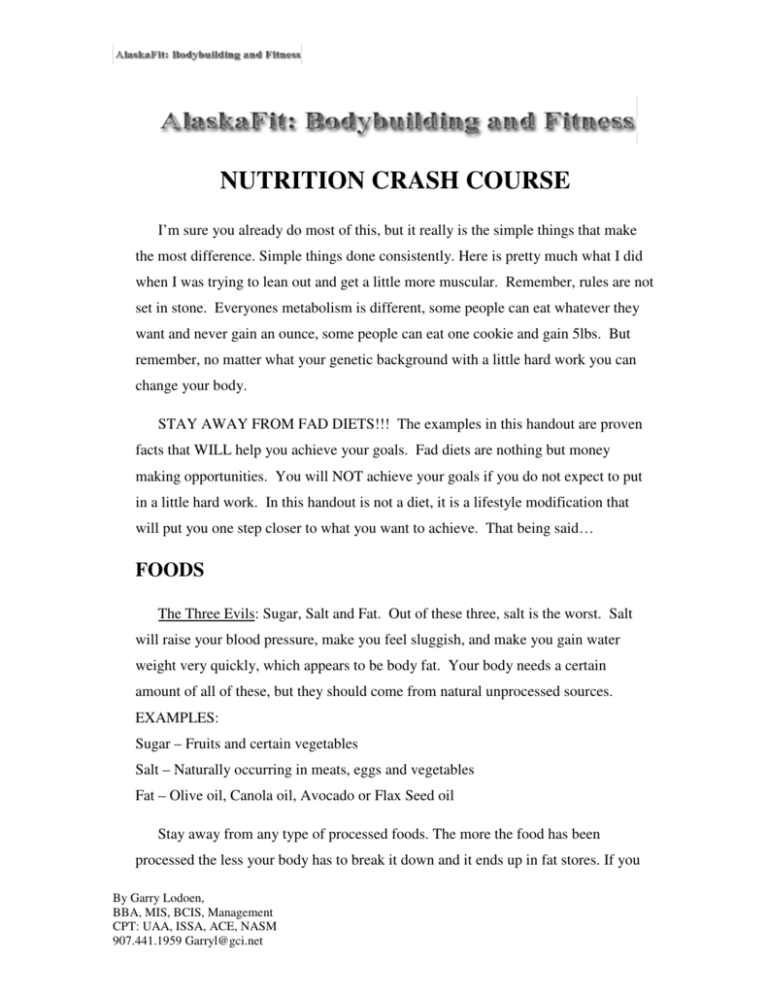
NUTRITION CRASH COURSE I’m sure you already do most of this, but it really is the simple things that make the most difference. Simple things done consistently. Here is pretty much what I did when I was trying to lean out and get a little more muscular. Remember, rules are not set in stone. Everyones metabolism is different, some people can eat whatever they want and never gain an ounce, some people can eat one cookie and gain 5lbs. But remember, no matter what your genetic background with a little hard work you can change your body. STAY AWAY FROM FAD DIETS!!! The examples in this handout are proven facts that WILL help you achieve your goals. Fad diets are nothing but money making opportunities. You will NOT achieve your goals if you do not expect to put in a little hard work. In this handout is not a diet, it is a lifestyle modification that will put you one step closer to what you want to achieve. That being said… FOODS The Three Evils: Sugar, Salt and Fat. Out of these three, salt is the worst. Salt will raise your blood pressure, make you feel sluggish, and make you gain water weight very quickly, which appears to be body fat. Your body needs a certain amount of all of these, but they should come from natural unprocessed sources. EXAMPLES: Sugar – Fruits and certain vegetables Salt – Naturally occurring in meats, eggs and vegetables Fat – Olive oil, Canola oil, Avocado or Flax Seed oil Stay away from any type of processed foods. The more the food has been processed the less your body has to break it down and it ends up in fat stores. If you By Garry Lodoen, BBA, MIS, BCIS, Management CPT: UAA, ISSA, ACE, NASM 907.441.1959 Garryl@gci.net eat a piece of broccoli, you have to chew it up… swallow it… your stomach acid has to break it down… you intestines have to move it through your digestive tract… and by the time its out of your body, your body has expended a large number of calories to process it. Now lets look at a piece of white bread: White bread has been ground up… bleached… additives added to it and then baked. When you eat it your body doesn’t have to work to process it, thus it will almost directly absorb into your body and turn into fat. Bread products, pasta, tortilla shells, most snack foods and even fat free cheese aren’t good. White bread is just as bad as eating plain table sugar. Don’t cut them, just limit them according to how fast you want to make your progress. You don’t have to measure your foods out exactly, it’s not the calorie that counts... its where the calorie comes from that makes the difference. Lunchmeats, Ham, Deli-meat, Sausage, Beef Jerky, Marinated Meats. All these are processed foods. In order to give packaged meats a longer shelf life they add sodium, nitrates and other things that will hinder your progress. Some people’s metabolisms can handle it better than others. Foods you should eat: Protein: Fresh (not frozen) Chicken, turkey, fish, lean steak, cottage cheese and fresh beans Carbs: (starchy) Rice, oatmeal, potatoes, (fibrous) fruits and vegetables, multi-grain breads (keep breads to a minimum) Fats: Flax seed oil, canola oil, olive oil Don’t go fancy, stick with the basic foods. Look at the labels of what you eat for foods low in salt fat and sugar. A good rule of thumb is Keep your sodium under 200mg, your Fats under 5g and your sugars under 5g per meal. It’s hard to eat out unless you know exactly what they put in your food, so be specific about what you want and ask questions. A good thing I used to use was NO SALT. You can purchase it at any grocery store. By Garry Lodoen, BBA, MIS, BCIS, Management CPT: UAA, ISSA, ACE, NASM 907.441.1959 Garryl@gci.net It tastes like seasoned salt but it’s made of potassium... it really flavors your food well without adding sodium and helps to cut excess water weight. BASIC RULES Water Water Water: Every chemical reaction takes place in water. Your body is 70% water. Water is the key to good health. Water flushes toxins out of your body and speeds up your metabolism. Drink a minimum of 1-1.5 gallons a day. Do this for a week and you will notice a difference. Eat small meals every 2-3 hours during the day: Every time you miss a meal your body senses that your starving so it begins to store what you eat as fat. To combat this, eat frequently through out the day. Eat larger meals in the morning and before you workout, and smaller meals at night before bed. Protein should remain constant throughout the day but you should cycle down your carbs in the hours before bed. Carbohydrates are for energy, Protein is for building muscle: Eat protein in small meals throughout the day. Your body does not have a protein “store” like carbs and fat. Carbs can be shuttled into the muscle and essentially “held on” to until your body needs it, fat can be stored all over for when your body needs it. Once you’re out of protein, your body cannot magically make it appear. Protein is the building block for your body’s muscle. If your body has no protein to digest, it will turn on its own muscle. Eat carbs when you will need energy: In the morning, before a workout, and a little bit immediately after your workout. If you eat carbohydrates when your body is at rest, your body does not need them so they are stored as body fat. If you eat carbs when you are active, your body burns them for energy. Keep your starchy carbs as low as possible during the last three hours before you go to bed. Cardio: The best time to burn body fat is after you wake up on an empty stomach. Your body has burnt off all the carbohydrates as you slept so if you do cardio vascular exercise on an empty stomach your body will burn off nothing but fat stores. By Garry Lodoen, BBA, MIS, BCIS, Management CPT: UAA, ISSA, ACE, NASM 907.441.1959 Garryl@gci.net The other best times to do cardio are after a weight training session or approx 1 hour before bed (do not eat after this session, it burns all calories out of your system so you do not store body fat in your sleep). 30-45 mins of intense cardio 3-5 days a week makes a tremendous difference. Digestion: Protein shakes only take about 1.5 hrs to digest, protein bars are about 1.52 hrs, meals are between 2.5-4 hrs. Always try to keep food in your stomach at about the digestion time of your last meal. This way your body doesn’t eat its own muscle as fuel. SUPPLEMENTS Truth: A lot of what you read in magazines and the newspaper is unscientific, unfounded and hype. I am a firm believer that SOME supplements are very good and can help your training immensely, but I am also a firm believer that there are some companies out there that just want to make money off of you. Don’t take a supplement because it is advertised as “the biggest breakthrough since protein!” Or that you can gain 300% more muscle by taking it. If this was true, we would all weight 240lbs at 3% body fat. You will only get between 5-10 % of your results from your supplements, 70% from diet and 20% from training. Remember, diet and training are the building blocks… supplements only enhance your natural ability. And remember the golden rule: Some supplements work for Some of the people, Some of the time. What I do believe in: Here are some supplements that are time tested and proven to enhance your training. Protein Powders: There are a million companies out there making protein powder these days and I could get into a lot of different things about them, but to make things easy, I use a product called “Whey Plex” by a company called BioPlex. It contains 5g of glutamine per scoop. Go to www.bioplexnutrition.com to learn more about it. If you want to go local, go to GNC and get Designer Whey Protein. Both are pretty good. Your Protein intake should be approx 1-1.5 grams per pound of bodyweight. By Garry Lodoen, BBA, MIS, BCIS, Management CPT: UAA, ISSA, ACE, NASM 907.441.1959 Garryl@gci.net EX: If you weigh 200lbs, you should consume between 200-300grams of protein per day. Most of this will be from real food sources, but you should always throw in 4-6 scoops of a protein shake per day to prevent muscle breakdown. Always take between 40-70 grams of protein after your workout!!! Vitamin mineral supplements – If you train a lot, Universal nutrition makes a very good comprehensive vitamin called “Animal Paks”, Otherwise GNC Mega Men, and a few other mainstream brands are just fine for the normal person. Ask someone at Natural Pantry or your local pharmacy. Take vitamins in the morning and after a workout if the directions say to take two a day. Creatine – Creatine has been around since the 1950’s. Despite all the hype, creatine is not a breakthrough supplement. It works very well to prevent muscle loss and helps some people increase strength and endurance. Take 5-7 grams before and after a workout. Do not cycle it (load and maintenance, if you don’t know what this is you can look it up online), this is just a waste of money. Glutamine – Glutamine is the most abundant amino acid in the human body. It prevents muscle breakdown and decreases recovery time. It also enhances your immune system. Take between 20-30 grams daily, 5-15g before and after a workout. B.C.A.A. Amino Acids – Branch Chain Amino acids are predigested proteins. They absorb directly through the stomach wall and prevent muscle breakdown. Take a few before and after a workout to prevent soreness. By Garry Lodoen, BBA, MIS, BCIS, Management CPT: UAA, ISSA, ACE, NASM 907.441.1959 Garryl@gci.net This is an article I ran into at www.bioplex.com. THE TRUTH ABOUT PROTEIN SUPPLEMENTS It seems like many companies will do just about anything to get you to buy their product. This includes making claims that are simply untrue. This is something BioPlex will not do. We all know that 95% of the supplements out there can’t do what they claim they can. Other companies sell you something, but then if you do your homework, you find out you didn’t buy what you thought you did yet they are legally within bounds. Let’s debunk some of these trickeries. HYDROLYZED PROTEIN Many companies will tout Hydrolyzed protein as the greatest thing since the wheel. Hydrolyzing is a form of predigesting the protein to make it more absorbable when eaten. The problem is that the micro fractions, which are so valuable in protein, are often times damaged when hydrolyzing it. Not only that, but hydrolysis makes the protein taste bitter. Most of the time, pure hydrolyzed protein is so bitter that it’s almost impossible to make it taste good without putting so much flavoring into it that it now resembles a meal replacement formula more than pure protein, due to all the added carbohydrates for the flavoring. Chances are that only a very small percentage of the mix is actually hydrolyzed protein (check your label.) Hydrolysis also increases cost so why would you want to pay more for something that tastes bad and gets damaged during the process? LABEL CLAIMS If you’re going to buy somebody else’s protein, be sure to look at the label. If you are buying Whey Protein Isolate (WPI), make sure that WPI is the only protein type listed in the ingredients. You see, a lot (I mean a LOT) of companies will call their product a WPI, but if you look at the label, you might see something like: Whey Protein Concentrate, Whey Protein Isolate, L-Glutamine·etc, etc. That’s because in the above example, they are using Whey Protein Concentrate (WPC) as the main ingredient and must list that first. There might only be a pinch of the WPI in the container while you thought you were getting pure Isolate. PROPRIETARY BLENDS Another gimmick many companies use is to claim some kind of proprietary blend for their protein. This allows them to skate around the whole label game. So, you buy some Whey Protein (or meal replacement pack or food bar, etc.) but the ingredient label might start with: MYCOGEN (A unique blend of Caseinate, Egg protein and Whey Protein Concentrate.) Notice that the Whey is the last one listed. That’s because by law, ingredients must be listed in order of total percentage of product. So although you may think you are buying pure Whey protein, in the above example, the most abundant By Garry Lodoen, BBA, MIS, BCIS, Management CPT: UAA, ISSA, ACE, NASM 907.441.1959 Garryl@gci.net product is cheap caseinate protein while the smallest percentage of protein is the Whey Protein. ALL WHEY PROTEINS ARE NOT ALIKE For the small handful of great whey manufacturers out there selling high-end Îsupplement worthy’ whey protein, there are a dozen of more that sell very low quality proteins. Any Company can buy a whey protein concentrate that only contain 35% protein (the rest being fat, carbs, ash, etc.), and sell that in a bottle as Whey Protein Concentrate. Unless you ran a analysis on it or really know your proteins, you probably wouldn’t even know you were using this cheap form of WPC until you started gaining body fat, started felling bloated, getting gas, etc., and not getting the results you wanted from using this stuff. You would be surprised at how many companies do this! They do it because they can get this type of protein at a fraction of the cost of good protein, so their profit margin is maximized. At BioPlex, we use only the highest quality proteins and highest purity percentages. There are also whey manufacturers that use processing methods that destroy or damage much of the micro fractions in the whey (usually through heat processes), making it useless. This protein is also cheap to buy and is abundant in products on the market today. Be sure you’re buying a quality whey product so you don’t get ripped off! Our whey isolate protein is the purest form of protein you can buy, and no heat processing is used, so all the important micro-fractions are preserved. SERVING SIZES You’ll often times see one product offering 20 grams of ÎSubstance A’ per serving, and then you’ll see another company offering the same product, but each of their servings contain 30 grams of the substance. At first glance, it seems like the second product is a better deal. I mean 30 grams per serving is better than 20 grams, right? However, closer inspection reveals that the serving size of the first product is 25 grams (one scoop), and the serving size of the second product is 50 grams, (two scoops.) Mathematically, this means that 8 out of 10 grams of the first product is the substance you want. In the second product only half or 5 out of 10 grams is the substance. As you can see, it is now obvious that the first product is a better buy. It is important to look at the nutrition labels and see how many grams are in a serving before determining that a product is better than another product. The formula is simple, but for the sake of simplicity we’ll spell it out: (Lets assume we’re talking about protein) Take the number of grams of protein in a serving (20 grams for example) and divide that by the number of grams in a serving size (28 grams lets say). This leaves you with 0.7142. Move the decimal to the right two places and you get 71.42% of each serving is protein the rest of it generally being carbs or fat. Armed with this knowledge, you can make better purchasing decisions. By Garry Lodoen, BBA, MIS, BCIS, Management CPT: UAA, ISSA, ACE, NASM 907.441.1959 Garryl@gci.net By Garry Lodoen, BBA, MIS, BCIS, Management CPT: UAA, ISSA, ACE, NASM 907.441.1959 Garryl@gci.net
